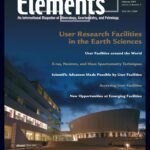Toxic Metals In The Environment: The Role Of Surfaces, September 2005, Vol. 1, No. 4
$20.00
Metals are prevalent in the environment. They are derived from both natural and anthropogenic sources.
Toxic Metals In The Environment: The Role Of Surfaces
September 2005, Vol. 1, No. 4
Metals are prevalent in the environment. They are derived from both natural and anthropogenic sources. Certain metals are essential for plant growth and for animal and human health. However, at excessive levels they are toxic. Metals undergo an array of processes, including sorption/desorption, precipitation/dissolution, and oxidation/ reduction, with reactive natural surfaces such as clay minerals, metal oxides, humic substances, plant roots, and microbes. These biogeochemical processes control the solubility, mobility, bioavailability, and toxicity of the metals. This issue of Elements explores research frontiers in the areas of metal mobility and reaction mechanisms on natural surfaces. These advances are explored at multiple scales, using state-of-the-art analytical techniques.
Why You’ll Love Elements Magazine:
- Expert Contributors: Articles written by renowned researchers in the field of geoscience.
- Engaging Content: Join a community of readers who are passionate about Elements.
- Exceptional Quality: Each issue is printed on high-quality paper with stunning visuals and detailed illustrations that bring complex scientific concepts to life.
Order your copy of the September 2005 issue of Elements magazine today and learn about the role of surfaces in toxic metals in the environment.
Related products
-
Carbon Dioxide Sequestration, October 2008, Vol. 4, No. 5
$20.00Storage of carbon in the subsurface involves introduction of supercritical CO2 into rock formations beneath the surface of the Earth, typically at depths of 1000 to 4000 meters. Although CO2 is a relatively benign substance, the volume being considered is large.
-
Nanogeoscience, December 2008, Vol. 4, No. 6
$20.00At first glance, nano and Earth seem about as far apart as one can imagine. Nanogeoscience seems to be a word connecting opposites.
-
Arsenic, April 2006, Vol. 2, No. 2
$20.00Arsenic is an element known throughout history as a classic poison. Currently, very small but highly significant concentrations of this element in drinking water supplies are causing massive health problems to many millions of people in some of the world’s poorest nations, and more localised sources related to mining and processing are also a concern.






